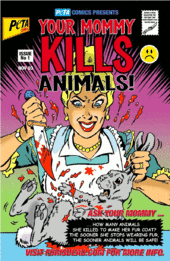An article called “How ‘saving’ animals at all costs can be a dangerous proposition” by PETA president Ingrid Newkirk, ran in several media outlets across the country a few days ago and appears intended to vilify the No-Kill movement. In the article Newkirk writes,
Shockingly, pressure to raise shelter “save rates” actually increases the “pet” overpopulation crisis. How? To reduce the number of animals it euthanizes, a shelter must reduce the number of animals it takes in by charging high “surrender” fees, putting people on waiting lists, sending unsterilized animals to “foster” homes and more. Many people cannot afford high fees, and those evicted from their own homes or entering a women’s shelter or nursing home can’t wait for weeks or months for their animal to be admitted. Cities learn the hard way that to play the “high-save-rate” game, something has to give. Because the number of homeless animals far exceeds the number of available homes, no matter what is done to try to conjure up more adopters, facilities are always full. Sick, injured, old, aggressive and other “unadoptable” animals are turned away – since accepting them would hurt the “save” statistics.
. . . To truly save dogs’ and cats’ lives, let’s reject this shelter “save-rate” nonsense and get to the root of the problem: the population explosion. Open-admission shelters, solid animal-control services, community education and reduced-cost spay-and-neuter programs are the keys to a real “save” rate.
Notice that Newkirk is still telling that half-truth about “pet overpopulation” while some communities in the country are shipping in dogs and cats precisely because there are so few dogs and cats in their community to adopt out from their local humane societies and animal controls.
For instance, the L.A. Times reports that,
Every day, hundreds of animals are taken in trucks, vans and cars from overcrowded Southern shelters, where euthanasia rates sometimes reach 70%, to states in the North, where puppies and kittens are not as plentiful . . . Animal advocates say the transports are here to stay, thanks to a supply and demand imbalance between the South and the North, where spay and neuter programs are far more widespread.
In other words, in many communities, the message about responsible pet ownership is getting out to the point where their animal controls and humane societies are lacking in animals, though some areas in the south may have some catching up to do. (And of course as the L.A. Times article points out, those allowing transports must ensure that those taking animals from one place to another are reputable organizations. Likewise states with high-kill rates must be educated about spaying and neutering, and/or offered more low-cost spay/neuter programs.)
These transports are not rare. In fact, you can do a web search for ‘shelter-to-shelter transport’ and find many articles about many organizations who are shipping animals to areas where there are deficits in pets to adopt. For example, USA Today wrote an article about shelter-to-shelter transport all the way back in 2009, noting,
Thousands of death-row dogs are getting reprieves every week, plucked from crowded, high-kill shelters and transported ” often hundreds of miles ” to places where there are open cages in shelters and open hearts in the community.
Shelter-animal relocations, known as “transfers,” have been quietly going on for years on a fairly small scale. But the numbers are escalating as growing legions of devoted rescuers organize ever-larger convoys; high-kill shelters initiate partnerships with faraway shelters that have space to accept out-of-luck animals; and large pet-advocacy groups develop strategies to increase the number of pets that are moved and saved every month.
You can thank the No-Kill movement for these saves, as well as organizations like PetSmart Charities’ Rescue Waggin’, Dogs on the Move, Pilots N Paws, Operation Roger, and Pup My Ride.
Likewise omitted from Newkirk’s drivel is the fact that, as Nathan Winograd, Executive Director of the No Kill Advocacy Center, notes in an article about PETA’s kill rates,
PETA is an organization that publicly claims to represent the best interest of animals ” indeed their ˜ethical treatment. Yet approximately 2,000 animals pass through PETAs front door every year and very few make it out alive.
The article about PETA’s kill rates continued:
PETAs euthanasia statistics are available to the public on on the Virginia Department of Agriculture and Consumer Services website…
The data reveals nearly 90 percent of the animals”1,647 cats and dogs”sheltered at PETAs headquarters in Norfolk, Virginia in 2012 were euthanized, and only 19 animals were adopted into new homes.
Further figures indicate PETA has killed a total of over 29,000 animals (mostly dogs and cats) at their headquarters, and the organizations euthanasia rates have only been increasing.
In addition, out of the 31,815 animals admitted to PETA shelters since 1998, only 3,159 were adopted”signifying a 9.7 percent adoption rate and an 87.2 percent kill rate.
So maybe Newkirk’s “virtue” disguises a hidden agenda. And what is that agenda? Let’s let Newkirk tell it in her own words:
In the end, I think it would be lovely if we stopped this whole notion of pets altogether. (Ingrid Newkirk, People for the Ethical Treatment of Animals, Newsday, February 21, 1988.)
Many animal rights activists are seldom if ever forthcoming with the public about the fact that they adhere to a movement called “nativism” which, as Nathan Winograd pointed out in Redemption: The Myth of Pet Overpopulation and the No Kill Revolution in America, could mean the elimination of domestic animal ownership. Winograd defines nativism as the,
. . . belief that the value of an individual animal comes from lineage and that worth as a species stems from being at a particular location first (79).
In the minds of many environmentalists and animal rights activists, since you cant set domestic animals free (after all, they are, according to them, unnatural human creations), you must necessarily kill them.
In these radicals view, in order to return to the natural order of things, indigenous species should take precedent over human encroachment, which they define as human domestication of animals, because wild (i.e. natural, indigenous), animals were there first. Another way to put that is, some animal rights and animal welfare organizations, as adherents of nativism, may not have an interest in saving pets lives, but may in fact be willfully seeking to exterminate them because pets are domesticated, not wild.
Nativism is most likely why youll often hear or read PETA’s Ingrid Newkirk describing PETAs high kill numbers as the result of giving supposed unwanted and sick animals a dignified, merciful death, which I guess for some of them means dumping their corpses in a dumpster. Of course its pretty easy to figure out that you cant find a pet a home if you never look for one, which might explain why 90% [of the animals] were euthanized within the first 24 hours of [PETA’s] custody according to the Virginia Department of Agriculture.

